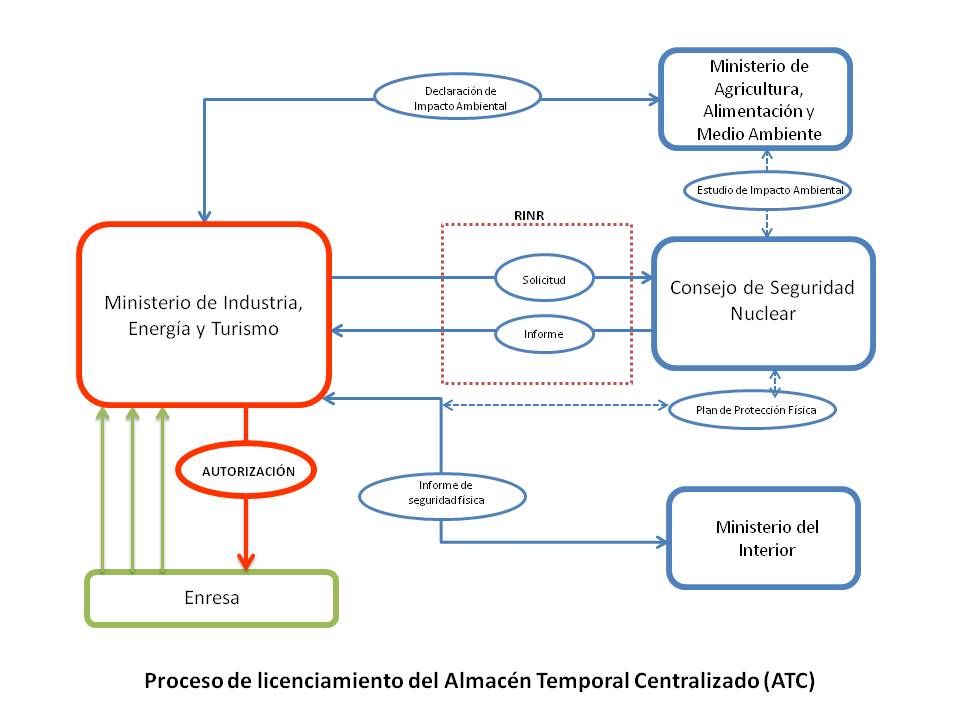Contenido principal
Desarrollo del proyecto ATC
Monografías
Almacén Temporal Centralizado
The basic priority objective of the Sixth General Radioactive Waste Management Plan, prepared by the National Radioactive Waste Company (Enresa) and approved by the Council of Ministers on 23rd June 2006, is the setting up of a Centralised Temporary Storage Facility (ATC) for the spent fuel and high level radioactive waste generated in Spain.
On 28th June 2006, the Spanish Nuclear Safety Council approved the basic conceptual design of a Centralised Temporary Storage Facility (ATC), without a specific location defined. The approval was based on the regulatory framework, the methodological approaches and the proposed set of codes and standards. The necessary limits and conditions for this type of facility were also set and can be seen on this Web site.
Process
The licensing of a facility is a process that involves a set of activities aimed at analysing compliance with the applicable regulations and the viability of granting one or more permits by which the relevant authorities authorize the recipient of the permit to carry out one or more activities. The Ministry of Industry, Energy and Tourism (Minetur) is responsible for granting authorisations for nuclear facilities taking into consideration a mandatory report by the Spanish Nuclear Safety Council. This entire process is regulated by Royal Decree 1836/1999 of 3rd December, approving the regulation on nuclear and radioactive facilities, modified by Royal Decree 35/2008 of 18th January, within Law 25/1964 on nuclear energy and Law 15/1980 creating the Nuclear Safety Council.
Once the generic design of the Centralised Temporary Storage Facility was approved and after choosing the site through a Resolution of 18th January 2012 of the Secretary of State for Energy (Official State Bulletin, 20th January 2012), the licensing process starts with the reception of the documentation associated with the applications for the prior or site authorisation and for the construction permit presented by Enresa to the Ministry of Industry, Energy and Tourism (Minetur).
At that time, that Ministry sends these applications to the Spanish Nuclear Safety Council for its study and analysis as well as the issuing of the relevant reports (mandatory and binding).
At the same time, Minetur sends the documentation related to the application for the Environmental Impact Statement (EIS) to the Ministry of Agriculture, Food and the Environment (Magrama). The bases and the scope for the prior environmental impact study to be included later in the EIS are supervised beforehand by Magrama and the CSN.
In parallel, Minetur requests the physical safety report for the facility to the Ministry of Interior, which is completed with the Physical Safety Plan that the CSN sends directly to the Minetur.
Once all the information from the official organisations taking part in the licensing process has been compiled, Minetur issues the operating permit for the spent fuel and high level radioactive waste Centralised Temporary Storage Facility.
Role of the CSN
For the CSN, the licensing process starts with the reception of the mandatory documentation presented by Enresa to Minetur, which in turn sends it to the CSN for its study and analysis and the issuing of the relevant report. At the end of the evaluation process, the CSN will determine the acceptability of the applications based on the analysed documentation and will propose the necessary changes, limits and conditions for each authorisation, as it considers necessary.
The control role of the CSN over the facility is not restricted to its design only, but also covers its entire life cycle.
An inspection plan is set for the construction phase to check that the assembly and installation of the facility is carried out in accordance with its design. Then, and before the facility enters into operation, a series of tests is carried out in the presence of CSN inspectors to proof the suitable performance of the structures, systems, components and equipment or parts that the facility consists of.
The inspection, supervision and control work by the CSN continues during the operation of the facility to ensure that the applicable regulations and the terms and conditions set out in the operating permit are complied with, all with the objective of checking the safe operation of the facility and that, therefore, both the radiation impact for the public and the environment and the doses for the facility personnel are as low as possible and, in any case, below the regulatory limits.

